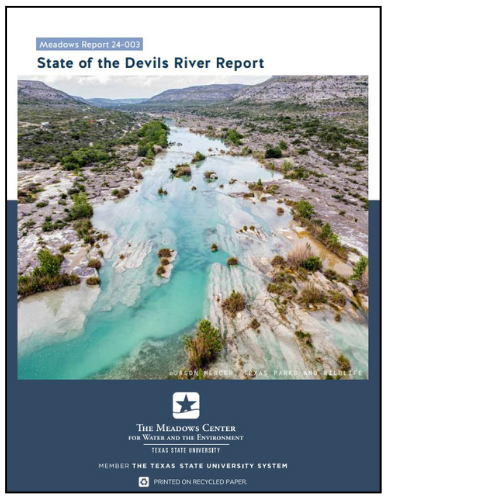The Devils River, one of Texas’ last untamed rivers, has long been a source of human inspiration and critical ecological value. The drive to protect its pristine waters and wild spirit against current and anticipated threats prompted Devils River Conservancy (DRC) to partner with The Nature Conservancy in Texas (TNC), the Texas Parks and Wildlife Department (TPWD), and The Meadows Center for Water and the Environment at Texas State University for the two-year-long Devils River Watershed Project. Its primary product, the recently released State of the Devils River Report, provides a comprehensive assessment of this treasured watershed. But beyond the report’s scientific insights, the project it was born from exemplifies how collaboration, transparency, and diverse stakeholder involvement can serve as a model for future conservation and resource management efforts.
A Holistic Approach to Watershed Stewardship
The purpose of the project was multifaceted:
- Establish a centralized reference for the current state of knowledge about the Devils River Watershed.
- Identify critical data gaps and research needs.
- Bring together technical experts from multiple disciplines to develop recommendations for addressing those gaps.
- Engage stakeholders in a meaningful way, ensuring diverse perspectives were reflected in the final report.
Through an iterative and inclusive process, this project and its report lay the groundwork for future conservation efforts which require an interdisciplinary approach to balance ecological preservation with the diverse and often disparate needs of the associated human community.
The Power of Collaboration: Technical Teams, the Stakeholder Jury, and Other Contributors
What sets this project apart is its innovative approach to ensuring a truly representative and scientifically rigorous outcome. The project incorporated four dedicated Technical Teams, each focused on a key aspect of watershed health: groundwater science, water quality, species and flows, and sustainable recreation. Experts from government agencies, nonprofits, academia, and private landownership and business contributed their knowledge, ensuring a comprehensive and interdisciplinary analysis of the scope of current data, issues, threats, and opportunities.
Recognizing that conservation solutions must reflect the voices of those who live and work in the region, the project also introduced a Stakeholder Jury. This group, selected through an open nomination process, represented private and public landowners, local leaders, recreationists, and other conservation advocates. The jury provided critical feedback on the report’s findings and process, ensuring that it remained balanced and aligned with shared community values. By vetting the content and guiding the report’s engagement strategy, the jury played a key role in fostering trust among stakeholders who have historically held differing views on resource management.
In addition to the Jury, non-selected stakeholders were actively invited to provide their feedback at various stages of the project, including multiple iterations of the report’s development. Feedback was solicited across multiple channels, including a dedicated project website, regular email outreach to all identified stakeholders, and notices in local newspaper outlets based within the watershed to reach additional community members. To further encourage engagement of all interested parties, interactive meetings were held at key stages of the project. Some events were held in Del Rio as an accessible central location for landowners and other community members, and virtual presentations were also offered to connect with stakeholders who could not attend in-person meetings.
All feedback collected from in-person and virtual communications with stakeholders was reviewed and addressed by the Technical Teams. These comments, questions, and additional resources assisted the Teams in strengthening the report as they identified remaining information gaps, areas requiring further clarification, and other considerations stemming from diverse perspectives on a given topic.
A Model for Future Conservation Efforts
The State of the Devils River Report is more than just an assessment of a unique watershed—it is a testament to the effectiveness of interdisciplinary collaboration. By integrating technical expertise with meaningful stakeholder input, the project navigated nuanced discourse on complex challenges while fostering shared ownership of final outcomes. This approach can serve as a blueprint for other conservation and sustainability initiatives facing similar dynamics of competing interests and scientific uncertainty.
Key Takeaways for Future Projects
- Transparency and Inclusivity: Engaging diverse voices in a clearly outlined and reported process from the outset builds trust and improves the quality of decision-making.
- Iterative Stakeholder Feedback: Creating multiple opportunities for input through accessible communication channels ensures that reporting and recommendations remain responsive to community concerns.
- Expert-Driven, Community-Approved: Pairing technical expertise with local knowledge leads to well-informed and widely supported solutions.
As the conversation around conservation and sustainable resource management evolves, the lessons from the State of the Devils River Report highlight the importance of finding common ground when making decisions for the future of our natural landscapes. By working together—researchers, policymakers, agencies, landowners, and other river advocates—we can find common ground and safeguard one of our most precious resources for generations to come.
—-----------------------
Special thanks go out to the team at The Meadows Center, led by Carrie Thompson and also including Anna Huff, Desiree Jackson, and Sarah Wingfield, who masterfully facilitated the project and compiled the resulting report into a cohesive product. This effort was supported by other members of the planning team, including TNC’s Ryan Smith, TPWD’s Sarah Robertson, and DRC’s own Romey Swanson and Dani Miller, all of whom lent their time and expertise to further ensure the project’s efficacy.
The report also could not have been completed without the diverse array of technical experts who contributed to data collection, critical discourse, and report writing within their Technical Teams. We recognize and appreciate their efforts along with those of the Stakeholder Jury, whose work led to key insights for identifying shared goals and addressing collective challenges. For a full list of contributors, please see the Report.


